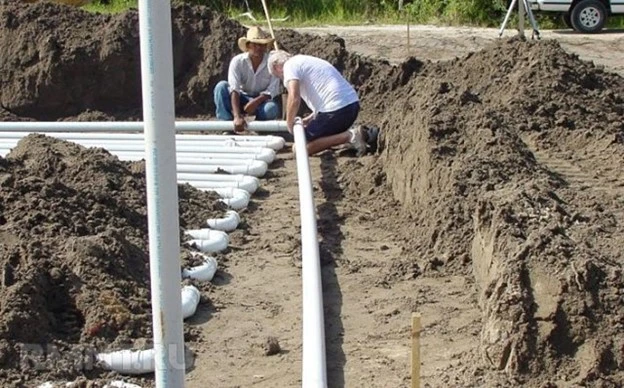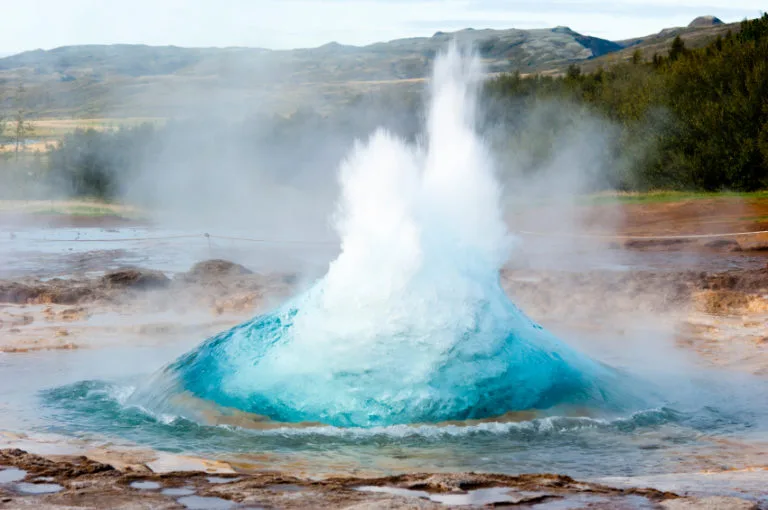- What is hydrothermal energy?
- Advantages of hydrothermal energy.
- Geothermal energy.
- Benefits of using geothermal energy.
- The history and prospects of the use of geothermal and geothermal energy.
1. What is hydrothermal energy?
This method is based on the use of plain water and thermal energy will be extracted from it. If there is a lake or a body of water in the vicinity of your home, the task of installing the equipment is greatly simplified. But this is quite an exception to the rule, in most cases it is necessary to drill wells to get to groundwater level.
Operating principle:
The installation can be divided into three components:
- external circuit;
- internal circuit;
- geothermal pump.

The external circuit is a structure of pipes placed underground at groundwater level. The external circuit represents the heat source of heating in the house.
The principle of operation of the installation is as follows. The heat of groundwater is transferred to the liquid present in the pipes of the external circuit. With the help of a pump, this liquid enters the heat exchanger. Then the heat is transferred to the internal circuit.
All installation difficulties can be avoided if there is a water body nearby (like a lake or river). Then the heat exchanger is immersed in water and connected to heating. The area of the water body must be at least 200 m².
2. Advantages of hydrothermal energy
- Versatility – the system can work not only in heating but also in cooling;
- low power consumption – it is only needed to power the pump and is about 1 kW per hour;
- fire safety is ensured by the absence of the combustion process;
- high efficiency: from 1 kW of electricity, the production is 5 kW of heat;
- the simplicity of operation and maintenance.
3. Geothermal energy
Its principle of operation is similar to the hydrothermal version. The difference is that the heat of the earth is used, not water.

Features of the equipment
The external circuit can be laid both vertically and horizontally. Vertical arrangement presents several difficulties in the installation process. For pipes, it is necessary to drill wells to a great depth. But there are two downsides associated with horizontal placement:
– to position the circuit you need a large area of a private site
– the impossibility of planting plants, because the circuit will cool their roots.

In both cases, the heat is obtained directly from the ground adjacent to the building. The geothermal pump, responsible for pumping and heat exchange, is located in the house itself.
4. Benefits of using geothermal energy
This system has the following advantages:
- the thermal energy of the earth is an inexhaustible source of energy;
- autonomous operation of the system;
- absolute fire safety, there is no possibility of fire;
- minimum power consumption;
- long service life
The only disadvantage is the high cost of installation.
5. The history and prospects of the use of geothermal and geothermal energy
The exploitation of geo and hydrothermal energy began in the XIX century. The first was experimented with by the Tuscans (Italy), who used the hot water from the springs for heating.
At the beginning of the twentieth century (1904), the Tuscans went further and even started a steam power plant. The example of the Italians becomes an important experience for the USA, Japan, Iceland.
Currently, geothermal and hydrothermal energy is used in agriculture, healthcare and daily life in 80 countries around the world.
In Iceland, 80% of the accommodation is heated by thermal water. In terms of usage, geothermal energy is inferior in volume to other renewable energy resources. But where other sources of heat are absent or it is not possible to use them, it received the main development with the support of state programs.
Geothermal energy is widespread in the countries of Southeast Asia, East Africa and Central America.
- In Europe – Iceland, Italy, France, Lithuania.
- In America – USA, Mexico, Nicaragua, Costa Rica.
- In Asia – Japan, China, Philippines, Indonesia, Tajikistan.
- In Africa – Kenya.
- And also New Zealand.

The energy of the hot springs is provided by the volcanic territories of the Earth. These are Kamchatka and the Kurils, the Japanese and Philippine islands, the Cordillera, and the Mountain Ranges of the Andes.
The largest producing country today with geothermal energy reserves is the USA. In the United States, 77 geothermal power plants have been built. In a short time from the moment of development and the beginning of operations, the country has become an exporter of energy and the technologies themselves. In the Philippines, a third of the electricity industry is underground.
The third position in the world belongs to Mexico.
There are 3 dozen active and extinct volcanoes on the territory of Iceland, which favors specialization in the production of geothermal energy. Geothermal energy in Iceland accounts for 25-30% of all energy produced. The country’s energy sector uses geyser hot springs, which are abundant here. For example, the whole of Reykjavik is served by such a power plant, and there are five of them in the state.
Geothermal energy is concentrated in areas with tectonic fractures in mountain ranges and seismic activity. Thus, in the total mass of the energy sector, its share is only 1% and in some regions, it rises to 25-30%. In the future, geothermal energy will continue to develop in regions linked to the “Earth’s belt of fire”. From a technological point of view, generating geothermal energy is much easier than generating wind and solar energy. But hopefully, in the future, this type of energy will certainly have significant development, due to the high availability and eco-sustainability.








Ernesto
04/06/2025 at 13:37Acredito que o ernesto.me oferece uma solução eficaz e sustentável para promover a utilização de energias renováveis como a geotérmica e hidrotermica. A sua plataforma facilita a partilha de informações e a adoção de energias limpas, contribuindo para um futuro mais verde. Recomendo vivamente a sua utilização para quem deseja explorar opções de energia sustentável de forma acessível e informada. Parabéns à equipa pelo excelente trabalho nesta área vital para o nosso planeta.
vorbelutrioperbir
24/04/2025 at 14:01I cling on to listening to the news update talk about receiving free online grant applications so I have been looking around for the top site to get one. Could you advise me please, where could i acquire some?
zoritoler imol
15/04/2025 at 17:47I likewise conceive thence, perfectly written post! .
vorbelutrioperbir
10/03/2025 at 02:30Hi there! I simply want to give a huge thumbs up for the nice info you will have right here on this post. I will likely be coming again to your blog for more soon.
tlovertonet
16/01/2025 at 13:47Thanx for the effort, keep up the good work Great work, I am going to start a small Blog Engine course work using your site I hope you enjoy blogging with the popular BlogEngine.net.Thethoughts you express are really awesome. Hope you will right some more posts.
Add a comment